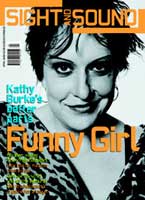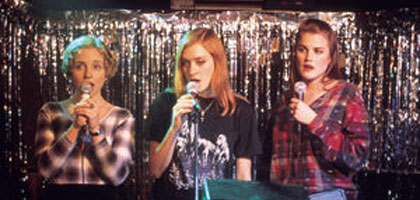
Boys Don't Cry
USA 1999

Reviewed by Xan Brooks
Synopsis
Our synopses give away the plot in full, including surprise twists.
The US Midwest, the early 90s. Teena Brandon, a petty thief from Lincoln, Nebraska, cuts her hair, binds her breasts and reinvents herself as a boy named Brandon Teena. Alighting in the depressed Nebraskan township of Falls City, Brandon befriends young single-mother Candace and her dropout buddies: ex-cons John and Tom and vixenish teenager Lana. John lives at the home of Lana's mother and is fiercely protective of Lana, who is herself attracted to Brandon. Lana and Brandon begin a relationship.
However, when Brandon's warrant sheet catches up with him, the authorities realise he is actually a girl and place him in the women's cell. Brandon tells Lana he is a hermaphrodite and she arranges his bail. Back at Lana's house, a disgusted John and Tom strip Brandon naked to prove he is actually a girl. Later that night, John and Tom drive Brandon to a remote part of the country where they rape and beat him. Brandon presses charges and hides out at Candace's home where he plans to escape Falls City with Lana. Informed of his whereabouts by Lana's mother, John and Tom drive over and kill Brandon and Candace. End credits reveal they are both serving time for murder. Lana left town but later returned to Falls City.
Review
Fledgling film-maker Kimberly Peirce first learned of the murder of Teena Brandon from a 1994 article in that oracle of New York hipness, the Village Voice. She developed it as a feature in tandem with quintessential East Coast indie-producer Christine Vachon, of Safe, Kids and Happiness fame. As a result, this glue-fume drama of disaffected American youth boasts an exotic, mongrel pedigree. Just as the charismatic, shape-shifting Brandon Teena arrives in Falls City, Nebraska, from "someplace beautiful", so Boys Don't Cry frames its big-sky, flat-land backdrop with a decidedly East Coast sensibility. Peirce's film casts Manhattan icon Chloë Sevigny as a small-town factory girl and filters its true-crime material through the prism of New Queer Cinema. A missive from the American Midwest, it is, paradoxically, very New York, very Village Voice.
Strange to note, then, that Boys Don't Cry's gender-bending concerns fit with a surprising snugness into its stolid heartland setting. After all, the American West has always trumpeted itself as a place of renewal and reinvention, a land where pioneers could throw off the shackles of the past and live the life they always dreamed of. And what is Teena Brandon if not a contemporary update of the 19th-century frontiersman, a sexual pioneer who sheds her old skin in Lincoln to become a plaid-shirted lad about town in Falls City?
Peirce elects to keep her protagonist's unhappy Lincoln experiences abbreviated, but the implication is clear. Teena Brandon is more successful as a man than she was as a woman. Rebranded as Brandon Teena, this lonesome petty thief becomes an admired confidant of the local toughs and an object of desire for both single-mum Candace and town temptress Lana. By playing Brandon this way, Peirce effectively turns the whole macho West on its Stetsoned head. In contrast with the self-possessed Candace and Lana, the film's two main male characters, John and Tom, are an insecure, emasculated ex-con and a subordinated self-abuser respectively. Both find themselves decisively 'out-boyed' by the handsome, sexually adept newcomer Brandon Teena who knows exactly how to please women, both carnally and emotionally.
Not that Boys Don't Cry is ever so obvious, so explicit in its gender politics. On the contrary, Peirce's picture is marked throughout by a lovely, lyrical ambiguity. Despite the sheer gut-churning horror of its central rape scene, the perpetrators are never demonised as brutish monsters, and while Peirce stacks the cards substantially in Brandon's favour (the director has admitted she "fell in love" with the character during the making of the film), Hilary Swank's wary, edgy interpretation saves him from becoming a simple martyr. Most impressive of all is Sevigny's perfectly weighted tour de force as Lana. For a start, the actress hits the right note physically: her heavy-jawed beauty contrasts nicely with Swank's more refined, aquiline looks and further blurs the tale's gender roles.
More importantly, Sevigny manages to conjure Lana into an astonishingly subtle and unreadable creature. We peg her for a dupe - a naive white-trash vixen who's in for a big surprise - only to realise that she is actually two steps ahead of everyone else. The enigmatic Brandon offers Lana a way out of her rut and the possibility of a real and lasting love. To quote the title of a Flannery O'Connor story, this girl understands a good man is hard to find. (Boys Don't Cry's atmosphere of surrealism and inarticulacy recalls O'Connor's similarly strange and depressed fictional worlds.)
Lana knows what she knows, trusts in her lover and is reluctant to dig any deeper. In the end, the relationship between Brandon and Lana turns out to be the crowning glory of Boys Don't Cry. On a stylistic level, of course, this poetic slice of trailer-park blues also takes its lead from the true-crime prose of In Cold Blood and The Executioner's Song or Terrence Malick's lovers-on-the-run classic Badlands (1973, similarly based on a true story). But in its themes, implications, and its haunting emotional resonance, Peirce's film stands alone. Boys Don't Cry is a crime story, a queer Western, a boy-meets-girl romance. It runs throughout on an almost unbearable sexual tension. In doing so, it shows the strange - and yes, beautiful - ways that love can go.
Credits
- Director
- Kimberly Peirce
- Producers
- Jeff Sharp
- John Hart
- Eva Kolodner
- Christine Vachon
- Screenplay
- Kimberly Peirce
- Andy Bienen
- Director of Photography
- Jim Denault
- Editors
- Lee Percy
- Tracy Granger
- Production Designer
- Michael Shaw
- Music
- Nathan Larson
- ©Twentieth Century Fox Film Corporation
- Production Companies
- Fox Searchlight Pictures and The Independent Film Channel Productions
- present
- a Killer Films/Hart-Sharp Entertainment production
- Developed with the assistance of the Sundance Institute
- Executive Producers
- Pamela Koffler
- Jonathan Sehring
- Caroline Kaplan
- John Sloss
- Co-producer
- Morton Swinsky
- Line Producers
- Jill Footlick
- NY Additional Photography:
- Jon Marcus
- Associate Producer
- Bradford Simpson
- Executives in Charge of Production
- Killer Films:
- Katie Roumel
- Hart-Sharp:
- Rachel Peters
- Production Office Co-ordinators
- Dee Evans
- NY Additional Photography:
- Rachel Dawson
- Production Manager
- Jamie H. Zelermyer
- Unit Production Manager
- NY Additional Photography:
- Jon Marcus
- Location Managers
- John Cadenhead
- Sherri Lennon
- Additional:
- Andrea Friedman
- Assistant Directors
- Jeanine Rohn
- Jim LaClair
- Alfie Kiernan
- W. Alex Korp
- NY Additional Photography:
- Jay Piro
- Script Supervisors
- Pamela Richardson
- Dallas 2nd Unit:
- Joni Linton
- NY Additional Photography:
- George Camarda
- Casting
- Billy Hopkins
- Suzanne Smith
- Kerry Barden
- Jennifer McNamara
- Local Director:
- Amy Grappell
- Additional Dialogue
- Laurie Weeks
- Directors of Photography
- Time Lapse Photography:
- John Pirozzi
- NY Additional Photography:
- Joe Arcidiacono
- Special Effects
- Jack Bennett
- Associate Editor
- Michelle Harrison
- Art Directors
- Shawn Carroll
- NY Additional Photography:
- Amy Silver
- Andrea Stanley
- Costume Designer
- Victoria Farrell
- Wardrobe Supervisors
- Michelle Elaine Teague
- NY Additional Photography:
- Sarah Beers
- Key Make-up/Hair/Effects
- Renée Lecuyer
- Make-up Artist
- Kalen Hoyle
- Key Make-up Artist
- NY Additional Photography:
- Jane Choi
- Key Hair/Make-up Stylist
- NY Additional Photography:
- Kerrie Plant
- Titles
- Scarlet Letters
- Ben Schoen
- Optical Effects
- Custom Film Effects
- Mark Dornfeld
- Music Supervisor
- Randall Poster
- Executive Music Producer
- Jim Dunbar
- Music Editor
- Allan Zaleski
- Soundtrack
- "Just What I Needed" by Ric Ocasek, performed by The Cars; "And It's All Right" by Andrew Shernoff, performed by The Dictators; "Space" by/performed by Butthole Surfers; "Bluest Eyes in Texas" by Van Stephenson, Dave Robbins, Tim Dubois, performed by (1) Nathan Larson, Nina Persson, (2) Chloë Sevigny; "A New Shade of Blue" by Bobby Fuller, Mary Stone Huffman, performed by Bobby Fuller; "That Lady Part 1" by Ernie Isley, Marvin Isley, Ronald Isley, Rudolph Isley, O'Kelley Isley, Chris Jasper, performed by The Isley Brothers; "Who Do You Love" by Elias McDaniel, performed by Quicksilver Messenger Service; "Haunt" by/performed by Roky Erickson; "Fan Blades of Love" by/performed by Ed Hall; "Burning House of Love" by Exene Cervenka, John Doe, performed by X; "Cod'ine" by Buffy Sainte Marie, performed by The Charlatans; "She's a Diamond" by David Robach, Kendra Smith, performed by Opal; "Tuesday's Gone" by Allen Collins, Ronnie Van Zant, performed by Lynyrd Skynyrd; "Rock Your Baby" by Harry W. Casey, Richard Finch, performed by George McCrae; "Boys Don't Cry" by Robert Smith, Laurence Tolhurst, Michael Dempsey, performed by Nathan Larson; "Why Can't We Live Together" by/performed by Timmy Thomas
- Sound Mixers
- Production:
- Mack Melson
- NY Additional Photography:
- William Kozy
- Re-recording Mixer
- Robert Fernandez
- Supervising Sound Editor
- Lewis Goldstein
- Dialogue Editor
- Jac Rubenstein
- Sound Effects Editors
- Glenfield Payne
- Sean Garnhart
- ADR
- Editors:
- Gina Alfano
- Hal Levinsohn
- Foley
- Supervisor:
- Jennifer Ralston
- Artist:
- Jay Peck
- Engineer:
- Matthew Haasch
- Stunt Co-ordinators
- Russell Towery
- Ben Loggins
- Cast
- Hilary Swank
- Brandon Teena
- Chloë Sevigny
- Lana Tisdal
- Peter Sarsgaard
- John Lotter
- Brendan Sexton III
- Tom Nissen
- Alison Folland
- Kate
- Alicia Goranson
- Candace
- Matt McGrath
- Lonny
- Rob Campbell
- Brian
- Jeannetta Arnette
- Lana's mom
- Cheyenne Rushing
- Nicole
- Robert Prentiss
- trucker
- Josh Ridgway
- Kwik Stop cashier
- Craig Erickson
- trucker in Kwik Stop
- Stephanie Sechrist
- April
- Jerry Haynes
- judge
- Lou Perryman
- sheriff
- Lisa Wilson
- Pam
- Jackson Kane
- Sam Phillips
- Joseph Gibson
- Tom
- Michael Tripp
- nerdy teen
- Shana McClendon
- girl in car
- Libby Villari
- nurse
- Paige Carl Griggs
- Dave, deputy
- Gail Cronauer
- clerk
- Certificate
- 18
- Distributor
- 20th Century Fox (UK)
- 10,656 feet
- 118 minutes 24 seconds
- Dolby digital
- In Colour
- Prints by
- DeLuxe
